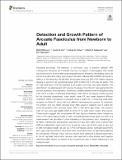| dc.description.abstract | Fractional anisotropy (FA) threshold is commonly used to perform diffusion MRI tractography. However, FA threshold may be one aspect of tractography that needs additional scrutiny in accurately assessing pathways in immature, developing brains, as well as in adult brains. Using high-angular resolution diffusion MRI (HARDI) tractography without an FA threshold, we identified the arcuate fasciculus (AF) of 83 healthy subjects ranging in age from 40 gestational weeks (GW) (newborns) to 28-year-old adults. The AF was identified in both hemispheres in all subjects with high inter-rater reliability. The detected AF included regions with very low FA values. The entire AF was segmented into anterior, posterior, and long tracts. Growth and laterality patterns were investigated using tract count (number of detected streamlines), total volume of imaging voxels (touched by the detected streamlines), mean length, mean FA, and mean apparent diffusion coefficient (ADC). Comparison of subjects under 3 years old, to those that were older, revealed the three AF tracts that took different developmental courses. As expected, the anterior and long tracts showed lower ADC values in subjects over 3 years old, while the posterior tract showed higher ADC in that same age range. The posterior tract did not show age-related effect in terms of FA, tract count, length, and volume. These results suggest that the posterior AF tract shows a matured state, indexed by most of the used measurements in early postnatal developmental ages, and ADC is a measurement that can detect further maturation of the posterior tract. Interestingly, in all tracts, hemispheric asymmetries were found in raw (left<right), and in whole brain (WB)-normalized (left>right) tract count, as well as in raw volume (left<right). In raw, and in WB-normalized length, as well as in WB-normalized volume, rightward asymmetry (left<right) was found only in the anterior tract; other tracts were not significantly affected by hemisphere. Although many previous studies have observed a leftward asymmetry in the AF, rightward asymmetry has also been reported in other studies, and together with the present report, the results in the literature are likely to reflect differences in the methods used. | en |


